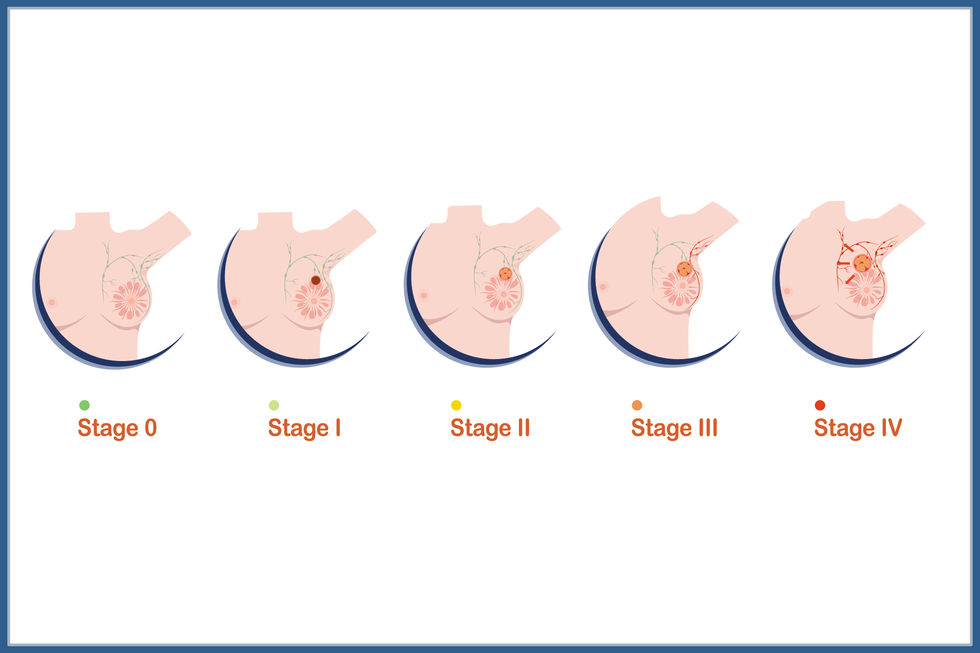
Medically reviewed by Tesia McKenzie, M.D.
Upon a breast cancer diagnosis, an important aspect of understanding the severity of the situation is the stage. The staging process involves determining how much cancer is present in the body.
There are various breast cancer staging systems, with the TNM system being the most widely used. This includes pathologic staging, which involves analyzing tissue from tumors and lymph nodes extracted during surgery, and clinical staging, which involves physical exams, biopsies, and imaging tests.
Staging considers factors such as tumor size, number of tumors, spread to nearby lymph nodes, metastasis, grade, biomarkers, level of HER2 protein, and gene expression profile results.
It is vital to know the stage as it informs treatment options, success likelihood, and the seriousness of the cancer. The stage can change throughout the treatment process, impacting treatment decisions.
Low stage numbers indicate less cancer in the body. Apart from stage numbers, sub-stage letters provide more precise details.
Understanding the stages of breast cancer and their treatment options is crucial. Here is an overview of each stage:
Stage 0 breast cancer
Cancer cells are non-invasive and have not spread beyond the ducts into surrounding breast tissue.
Treatment options for stage 0 breast cancer
Stage 1 breast cancer
Cancer is localized or a small amount is found in the sentinel lymph node.
- Stage 1A breast cancer: Tumor is smaller than 2 centimeters and lymph nodes are not affected
- Stage 1B breast cancer: The cluster of cells is less than 2 millimeters, with or without a tumor in the breast
Treatment options for stage 1 breast cancer
- Breast-conserving surgery
- Mastectomy
- Radiation
- Hormone therapy
- Chemotherapy
Stage 2 breast cancer
Tumors are larger but still in the breast and/or nearby lymph nodes.
- Stage 2A breast cancer: Tumor is less than 2 centimeters and has spread to 1 to 3 lymph nodes, or the tumor is 2-5 centimeters without spreading to the lymph nodes
- Stage 2B breast cancer: Tumor is 2-5 centimeters and has spread to 1 to 3 lymph nodes, or larger than 5 centimeters and not spread to lymph nodes
Possible treatments for stage 2 breast cancer
- Breast-conserving surgery
- Mastectomy
- Radiation
- Hormone therapy
- Targeted drug therapy
- HER2 targeted therapy
- Immunotherapy
Stage 3 breast cancer
Tumors are large and growing into surrounding tissues and/or have spread to lymph nodes but not other organs.
- Stage 3A breast cancer: Cancer has spread to 4 to 9 lymph nodes, or the tumor is more than 5 centimeters and cancer has spread to lymph nodes
- Stage 3B breast cancer: A tumor of any size has grown into the chest wall or skin and/or spread to 9 lymph nodes
- Stage 3C breast cancer: No tumor in the breast or any size tumor in the breast, with cancer in 10 or more axillary (underarm) lymph nodes, internal mammary nodes or lymph nodes near the collarbone
Treatment options for stage 3 breast cancer
- Surgery (most often mastectomy)
- Chemotherapy
- Radiation
- Targeted therapy
- Hormone therapy
Combination treatments are likely for this stage.
Stage 4 breast cancer (metastatic)
The cancer has spread outside of the breast and nearby lymph nodes to other parts of the body.
- Stage 4 breast cancer is considered incurable and treated as a chronic condition
Possible treatments for stage 4 breast cancer
- Chemotherapy
- Targeted drugs
- Immunotherapy
- Hormone therapy
Radiation and surgery may also be an option based on diagnosis.
Related Articles Around the Web




